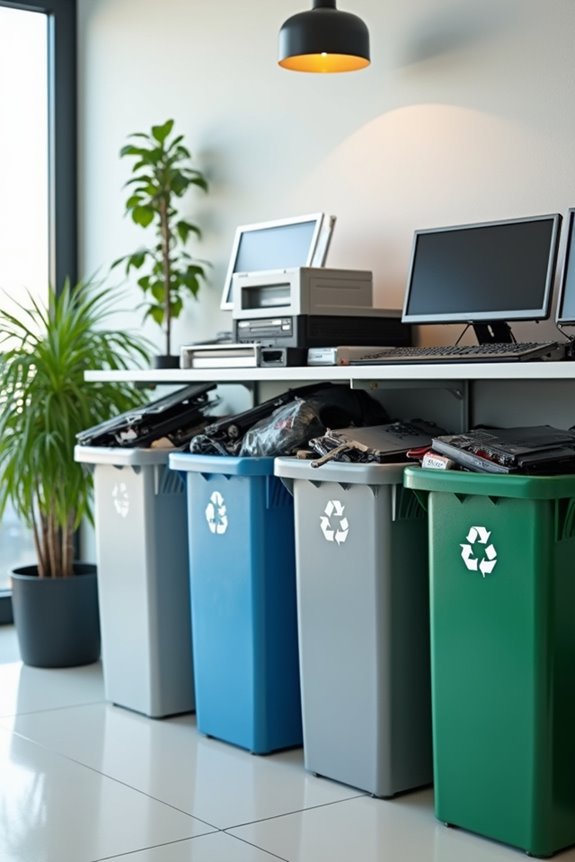To properly recycle office equipment, I start by identifying all recyclable items, including computers, printers, and peripherals. I then establish a disposal policy that includes data sanitization and compliance tracking. Assigning specific personnel to manage equipment guarantees accountability. It’s crucial to choose a certified recycler to ensure safe disposal. I also promote a culture of sustainability within my organization. If you’re interested in detailed practices and tips, there’s more to explore on this topic.
Key Takeaways
- Identify all recyclable office equipment, including computers, monitors, printers, and peripherals like routers and toner cartridges.
- Establish a clear disposal policy that includes data sanitization methods to protect sensitive information.
- Designate responsible personnel for managing equipment inventory and disposal processes.
- Coordinate logistics for decommissioning equipment, ensuring compliance with lease terms and proper documentation.
- Promote a culture of sustainability by engaging employees in recycling efforts and recognizing their contributions.
Identify Equipment for Recycling
When it comes to recycling office equipment, the first step is identifying what can be recycled. In my experience, electronic waste is a significant component of office environments. You can start by examining computers, laptops, and their peripherals, as they contain materials suitable for recycling. Additionally, servers, monitors, and printers often have recyclable parts.
Following recycling guidelines, I recommend also checking items like routers, fax machines, and even toner cartridges, which are often recyclable. Remember, not all office equipment falls into the electronic waste category; furniture and certain office supplies may be repurposed or recycled differently. By identifying recyclable items, I guarantee our office minimizes waste and adheres to responsible recycling practices.
Establish a Comprehensive Disposal Policy
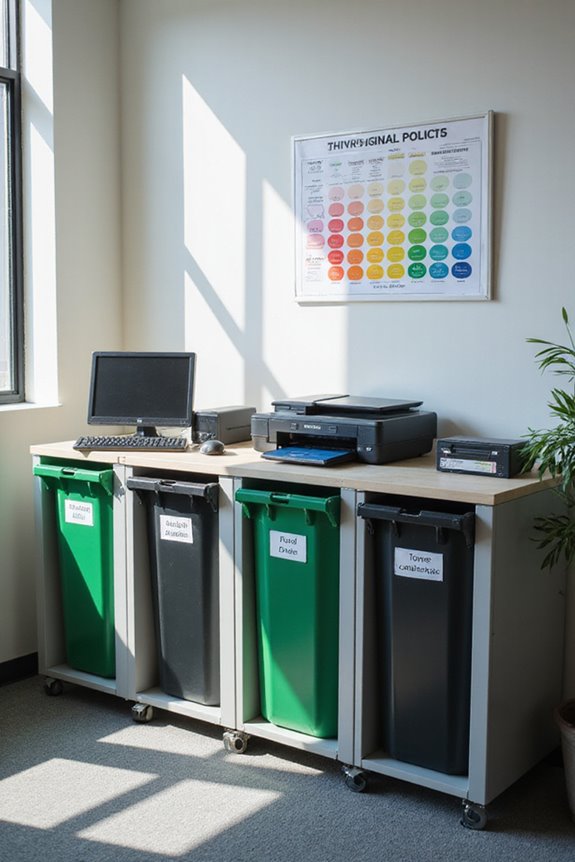
Establishing an extensive disposal policy is an important next step after identifying which office equipment can be recycled. This policy should include clear procedures for inventory management, ensuring we track equipment throughout its lifecycle. I recommend using proper disposal channels, such as electronic recycling bins or certified recycling facilities, to comply with environmental regulations.
Data sanitization methods are essential; employing software like Blancco can protect sensitive information. Additionally, it’s critical to maintain records of disposal activities for compliance audits. By focusing on sustainable practices—like refurbishment, donation programs, and recycling options—we can greatly reduce electronic waste. Regularly reviewing and updating our recycling policies will keep us aligned with industry developments and legal requirements, ensuring responsible disposal methods are in place.
Assign Responsibilities for Equipment Management
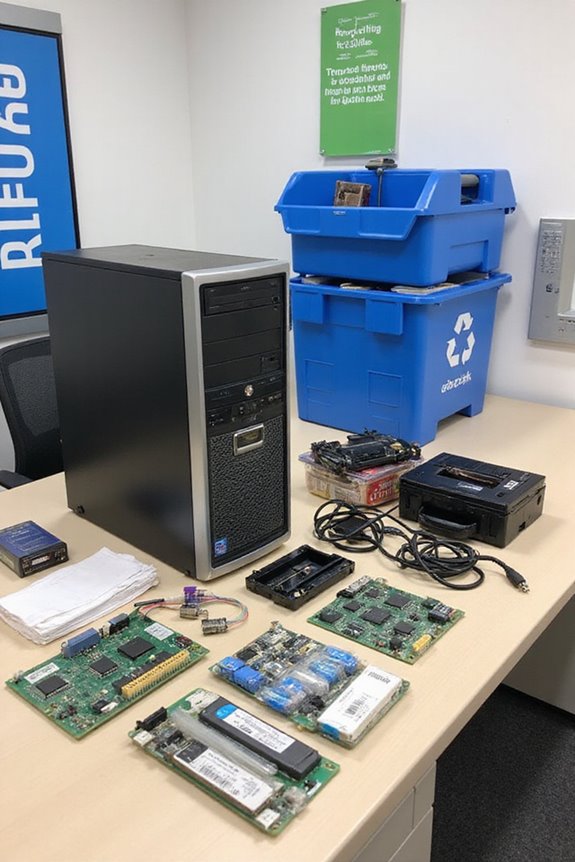
Assigning clear responsibilities for equipment management is essential to maintaining an organized and efficient office environment. To create an effective accountability framework, I recommend designating specific personnel or teams to oversee office equipment. This includes tracking equipment usage, condition, and location. Each department should have ownership of the equipment assigned to them, reducing loss and misuse.
Establish a point of contact for any equipment-related issues and communication with service providers. Implement an asset register that’s regularly updated, utilizing barcoding or RFID systems for accurate tracking. Regular audits should be scheduled to verify equipment presence and condition. Finally, guarantee all personnel receive training on proper equipment use, reinforcing accountability throughout the organization.
Plan Logistics for Decommissioning

Planning the logistics for decommissioning office equipment is essential, especially as you prepare to shift your workspace. First, I recommend reviewing your lease terms to understand any specific requirements. Next, create a detailed decommissioning timeline to guarantee all tasks proceed smoothly.
- Vendor Coordination: Schedule meetings with vendors responsible for equipment removal and disposal. This guarantees everyone is aligned on timelines and expectations.
- Identify Equipment: Determine which items need removal, like computers and copiers.
- Arrange Transport: Plan for transportation to either storage or disposal sites.
- Document Everything: Keep records of equipment removal for compliance.
Ensure Data Security and Destruction
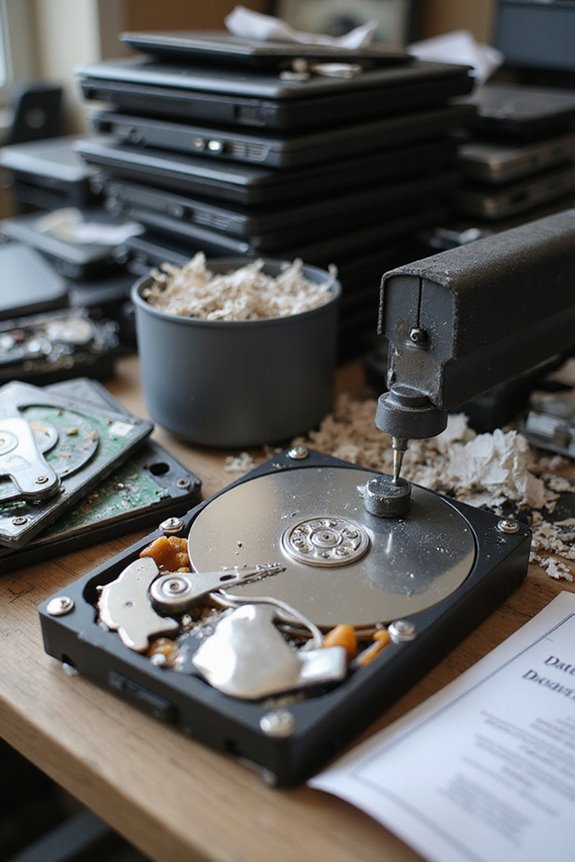
Ensuring data security during the decommissioning of office equipment is an important step that can’t be overlooked. First, I classify the data according to its sensitivity. This helps me determine the right destruction method that meets compliance standards. For highly sensitive data, I prefer physical destruction methods like shredding or crushing hard drives, ensuring data’s irretrievable. Alternatively, logical destruction methods, such as digital shredding, can be effective for less critical information. It’s essential to obtain a certificate of destruction, documenting that I’ve followed the necessary procedures. By adhering to these standards, I not only protect sensitive information but also maintain regulatory compliance, which is fundamental in today’s data-driven landscape.
Clean and Organize Equipment for Transport
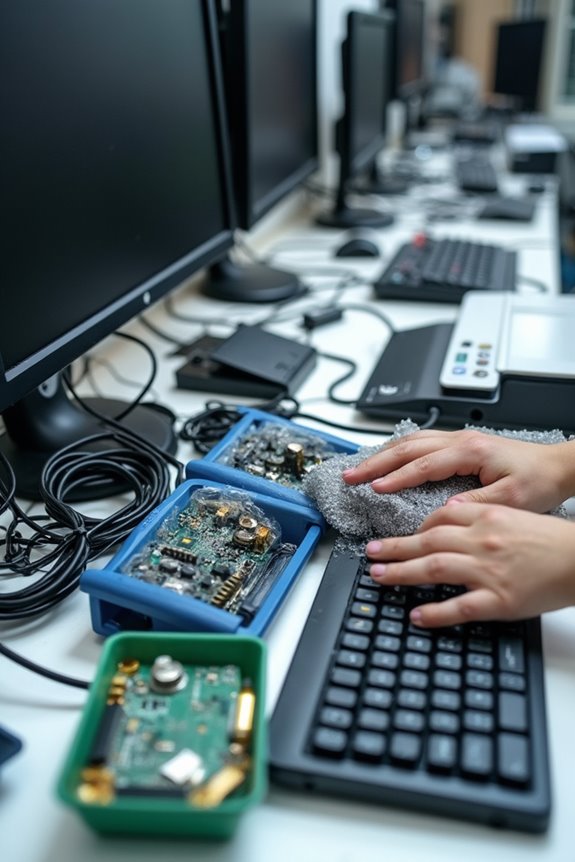
To effectively prepare office equipment for recycling, I focus on a systematic approach that emphasizes organization and safety. First, I apply cleaning techniques to wipe down devices, removing dust and debris to enhance handling. Next, I implement organizing strategies by designating a specific area for equipment. This minimizes disruption during business hours and guarantees easy access for recycling services.
I carefully unplug all cables and secure any moving parts to prevent damage. Additionally, I clearly label each box with its contents to streamline the recycling process. I also take special care with fragile components, segregating hazardous materials like batteries. By following these steps, I guarantee that the equipment is well-prepared for transport, promoting a safe and efficient recycling experience.
Choose a Certified Recycler
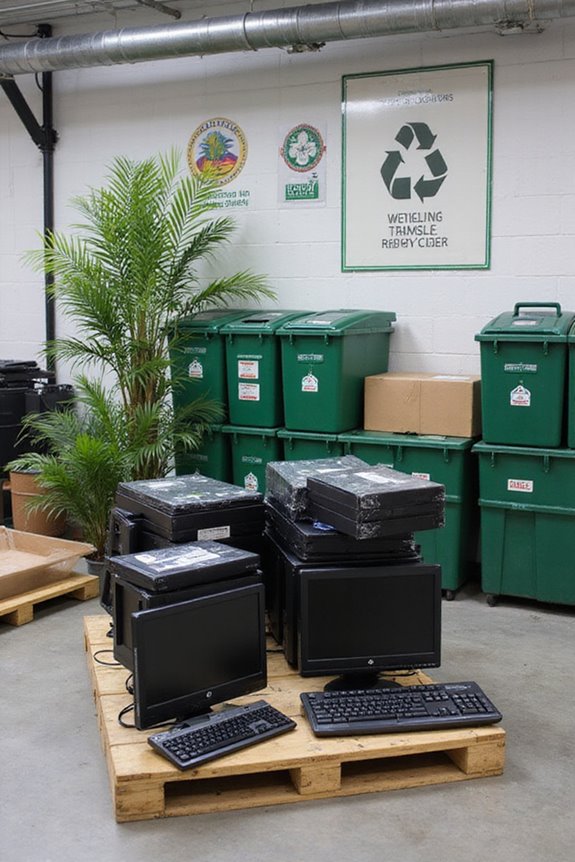
Choosing a certified recycler is an essential step in the office equipment recycling process. The certification importance can’t be overstated, as it guarantees that recyclers meet stringent environmental, health, and safety standards. When I evaluate recyclers, I check for well-known certifications like R2, e-Stewards, or RIOS™. These accreditations indicate that they responsibly handle equipment, including secure data destruction and material recovery.
To make a wise choice, I confirm their documented management systems and ongoing compliance through independent audits. Additionally, I verify their data destruction policies are explicit, ideally backed by NAID AAA certification. By following these steps, I can be confident that I’m partnering with a recycler committed to minimizing risks and maximizing responsible recycling practices.
Understand the Environmental Benefits of Recycling
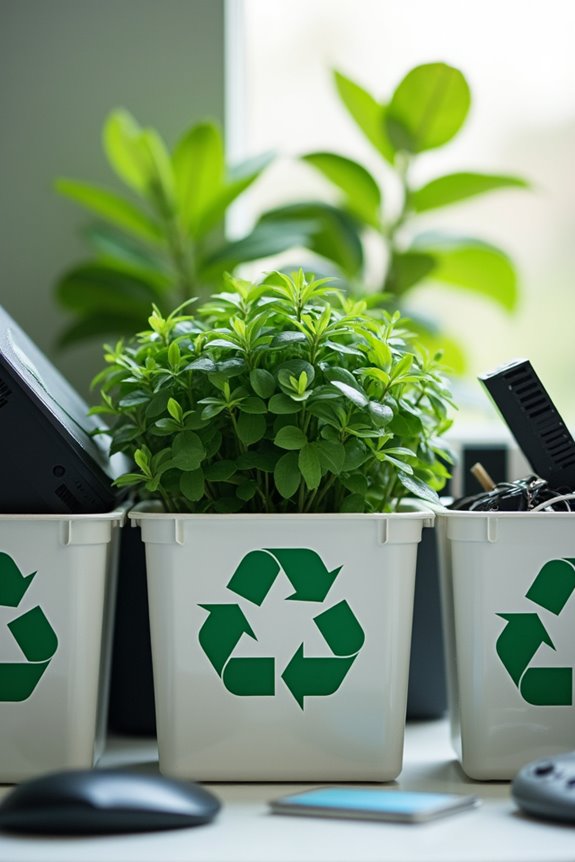
Understanding the environmental benefits of recycling office equipment is vital, especially as we face increasing challenges related to e-waste. The environmental impact of improper disposal is significant, with millions of tonnes of e-waste generated annually. By recycling, we can reduce greenhouse gas emissions and conserve energy, which is essential in today’s climate crisis.
Recycling benefits include conserving non-renewable resources and minimizing hazardous waste sent to landfills. Proper recycling guarantees that toxic substances, like lead and mercury, are disposed of safely, protecting both ecosystems and public health. Additionally, recycling creates economic opportunities through job creation and revenue generation. Emphasizing these benefits helps foster a culture of responsibility and sustainability in our communities.
Maintain Documentation and Follow-Up Procedures
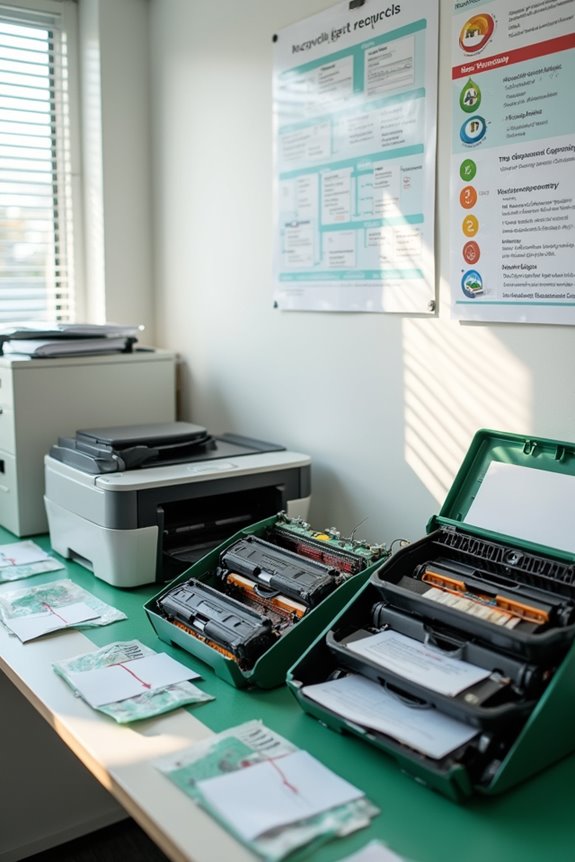
Maintaining proper documentation and follow-up procedures for recycling office equipment is essential, as it not only guarantees compliance with regulatory standards but also enhances accountability within our organization.
- Comprehensive Inventory: I keep detailed records of every recycled item, including model, make, serial number, and condition. I also note the disposal method and track devices with sensitive information that require data destruction.
- Disposal Verification Forms: For each disposed device, I implement a verification form documenting data sanitation methods and responsible personnel.
- Auditing: Regular audits of inventory logs and verification forms guarantee accuracy. I address discrepancies promptly, using audit processes to refine our disposal policies.
Promote Recycling Success Within the Organization
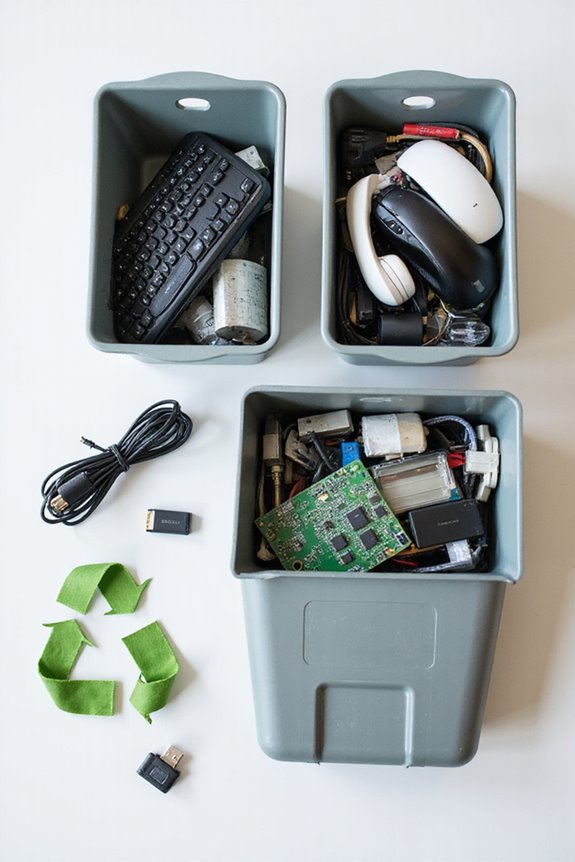
Promoting recycling success within the organization is essential, especially as it fosters a culture of sustainability and responsibility among employees. To achieve this, I recommend several key steps:
- Leadership Endorsement: Guarantee leadership clearly communicates the recycling vision and policies to all staff.
- Employee Engagement: Regularly conduct workshops and share success stories to keep employees informed and motivated.
- Infrastructure: Replace individual trash bins with centralized recycling stations, clearly labeled for easy use.
- Recognition Programs: Implement incentives for departments that meet recycling milestones, encouraging friendly competition.
- Feedback Loop: Regularly review policies based on employee input and waste audits to continuously improve recycling initiatives.
Frequently Asked Questions
Can I Donate Old Office Equipment Instead of Recycling It?
I’ve found that donating old office equipment is a great option instead of recycling. It extends the equipment’s lifespan and supports local organizations. Plus, it feels good knowing I’m helping my community thrive.
What Types of Equipment Are Typically Not Recyclable?
When I think about non-recyclable materials, I realize many office items, like damaged electronics and specialty plastics, contain hazardous components. It’s frustrating knowing that some things just can’t be recycled properly.
How Often Should We Recycle Office Equipment?
Imagine tending a garden; regular weeding keeps it healthy. Similarly, I follow frequency guidelines for recycling. Establishing a recycling schedule guarantees my office equipment blooms longer, preventing clutter and keeping our environment thriving.
Are There Any Costs Associated With Recycling Office Equipment?
Yes, there’re costs associated with recycling office equipment. I’ve found that recycling fees can vary based on disposal options available, so it’s crucial to research local services to understand what charges might apply.
What Happens to Recycled Office Equipment After Collection?
You wouldn’t believe the journey recycled office equipment takes! It’s like a second life—through the recycling process, it’s transformed, extending its lifespan while precious materials are reclaimed, keeping our planet healthier and happier. Isn’t that amazing?

